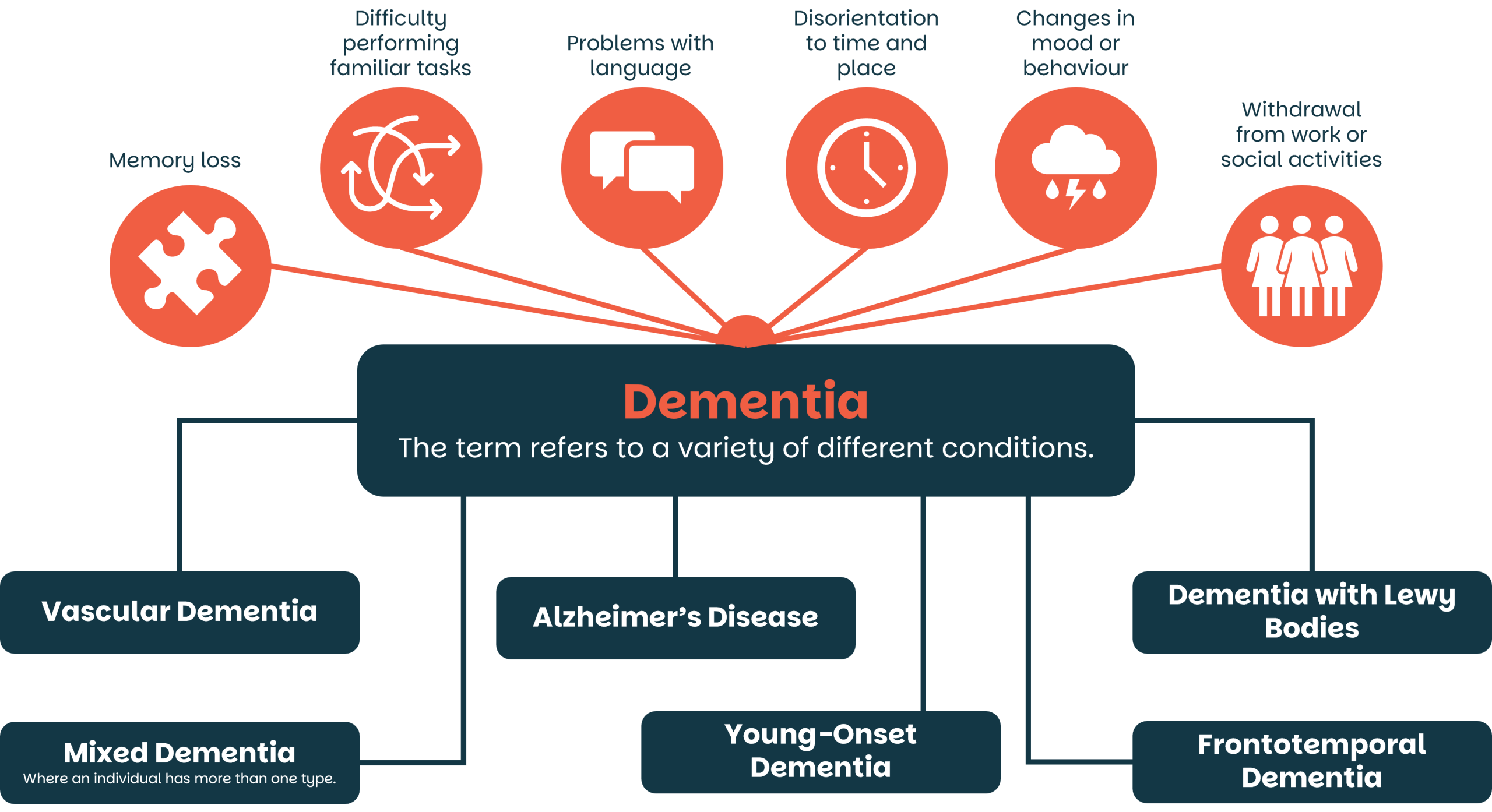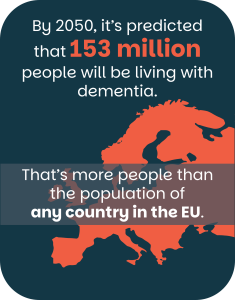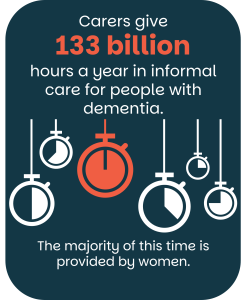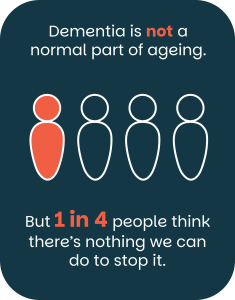Beyond Forgetfulness: Untangling Dementia and Alzheimer’s Disease



We all forget things now and then. But what happens when memory loss is more than just everyday forgetfulness?
When people talk about memory loss or changes in thinking, the words dementia and Alzheimer’s disease often get used as if they are the same thing. They aren’t. Dementia is the broader term for a range of symptoms that affect memory, thinking, and daily life, while Alzheimer’s disease is the most common cause of dementia. Understanding the difference helps us make sense of the statistics, the impact on individuals and families, and why awareness really matters.
What is Dementia?
Dementia is not a single disease. It’s an umbrella term to describe a collection of symptoms experienced when living with diseases or conditions that affect brain health. Diseases grouped under the term dementia are caused by abnormal brain changes. These changes trigger a decline in thinking skills, also known as cognitive functioning, and can affect learning, memory, language, behaviour, feelings and relationships.
The defining feature of the various diseases or conditions under the umbrella term of dementia is that they are progressive and persistent – an individual’s cognitive function gets worse over time.
People often get confused about the difference between Alzheimer’s disease and dementia. Alzheimer’s disease is a type of dementia, accounting for 70% of total dementia cases. When combined with vascular dementia, these two diseases make up the vast majority of dementia cases – up to 90%.1

What Are the Signs and Risk Factors of Dementia?
Several early signs can suggest someone is suffering from dementia. These can include – but aren’t limited to – memory loss, misplacing things, or sudden changes in mood and behaviour. Whilst we all occasionally forget things or misplace an object, people with dementia often do so increasingly frequently, and will struggle to retrace their steps. They may also put things back in unusual places. One of the challenges of dementia is that the individual themselves may not be aware of their own struggles.
Dementia can strike anyone, across social or economic boundaries. A recent report on dementia from the Lancet Commission2 identified 14 modifiable ‘risk factors’ at different stages of an individual’s life. At the early life stage, a poor education is the predominant risk factor of dementia. In adulthood, between 18-65 years old, hearing problems and high LDL cholesterol could be linked to 14% of sporadic (arising in individuals without a clear family history of the illness) dementia cases. In later life, above 65, age is the highest risk factor – but modifiable risk factors, such as social isolation, air pollution, and visual loss, also account for 10% of sporadic dementia cases.2,3
After the age of 65, a person’s risk of dementia increases – roughly doubling every five years. At 65, 2 in every 100 people have dementia. By the age of 90, it’s up to 33 in every 100. There is, however, very little research and data on the estimated numbers of people with dementia under 65, and more research is needed.
Behind every statistic is a real person, a family, and a story. Although everyone’s experience of dementia is different, over time, those affected will be unable to care for themselves and need help with most aspects of daily life.
Treatments are being developed. Disease-modifying treatments that use ‘amyloid beta antibodies’ – known as passive immunotherapy – have been approved in the United States and Europe in 2023 and 2024 respectively. This treatment helps people in the early phases of dementia, during the initial mild cognitive impairment stage (MCI). However, there is still a lot of work to be done in understanding the causes of dementia and how we can help those with it.
Dementia Prevalence
Every three seconds, someone new develops dementia. That’s the time it took for you to read the sentence.
Rates of dementia are increasing globally. In 2020, more than 55 million people worldwide were living with dementia, with Alzheimer’s disease responsible for 70% of these cases . This number is expected to nearly double every 20 years, potentially reaching 153 million by 2050.4

Alzheimer’s Disease and other forms of dementia are the 7th leading cause of death internationally.5 With ageing populations across the globe, it will become an ever-increasing challenge. This impacts both people’s lives and health and social care systems globally.
Additionally, a huge amount of care is done informally by family members looking after people with the disease. The amount of informal care given is estimated to be around 133 billion hours globally, of which the majority is provided by women.5

While statistics help us understand the scale of dementia, it’s important to remember that each number represents someone’s parent, partner, friend, or neighbour. These conditions touch lives in very real and personal ways.
What is Alzheimer’s Disease?
Alzheimer’s disease (‘Alzheimer’s’) is a neurodegenerative disease and is the most common cause of dementia. As it progresses, Alzheimer’s damages a person’s neurons. The damage begins in someone’s brain 10 to 20 years before any effects are seen, but will eventually cause the outward symptoms of dementia to emerge – all part of a progressive worsening of cognitive skills.
Like all types of dementia, Alzheimer’s affects everyone differently. It usually starts in and around the area of the brain responsible for memory. Other early symptoms can include thinking and reasoning difficulties, language problems, changes to how people see or hear things, mood changes and sometimes depression. For people living with the disease, this can mean navigating daily challenges — from remembering appointments to recognising familiar faces.
Alzheimer’s initial effects are mild, causing MCI – ‘mild cognitive impairment’ – and won’t prevent individuals from doing activities in their day-to-day life. However, the symptoms will worsen over time, and individuals will need increasing levels of help as the disease progresses.
The causes of Alzheimer’s disease are still under investigation. Two features in the brain – amyloid beta peptides and tau protein – can accumulate in brain tissue and cause build-ups. These are associated with damage to the cells in the brain, including neurons. Amyloid beta peptides form ‘plaques’ between all types of brain cells, and tau forms ‘tangles’ inside nerve cells, which can affect the brain’s functioning. We don’t fully understand what causes these two elements (amyloid and tau) to build up. The outward symptoms depend on where in the brain cells are damaged.
It appears that women tend to be more vulnerable to Alzheimer’s disease than men. Around twice as many women have Alzheimer’s as men.6 Whilst women do live longer than men on average, and therefore have an increasing risk in older age, this doesn’t fully explain the difference. Some studies suggest that this is due to the onset of menopause7, when remodelling of synaptic connections (the links between cells in our brains) occurs due to hormonal shutdown. It could also be due to lifestyle differences caused by gender roles, genetics or vulnerability to brain injuries.6
When combined with the fact that most of the care for those living with dementia is undertaken by women, women are disproportionately affected.
Other Types of Dementia
Whilst ExpoSignalz focuses on Alzheimer’s disease, there are several other types of dementia. These include:
- Vascular dementia is the second most common type of dementia (representing approximately 20% of all cases). It tends to affect planning, organising, decision-making and problem-solving first. All types of vascular dementia are caused by issues with the blood supply to the brain.
- Dementia with Lewy bodies (known as DLB) is caused by clumps of the synuclein protein forming inside brain cells. These abnormal deposits are called Lewy bodies. These deposits are also found in people with Parkinson’s disease, and they build up in areas of the brain responsible for functions such as thinking, visual perception and muscle movement. It can cause difficulties with focus, delusions and disruptions to sleep and movement.
- Frontotemporal dementia is less common and can cause personality changes. This is mostly diagnosed in people under 65 and is caused by damage to the nerve cells in the frontal and temporal lobes.
- Early-onset dementia and mixed dementia don’t refer to specific diseases, but rather their nature. ‘Early onset’ means that it affects someone under 65. Mixed dementia is when someone suffers from different versions of dementia simultaneously.
Attitudes Towards Dementia
There are many misconceptions about dementia. One in four people thinks there is nothing we can do to prevent it, yet at least 40% of dementia cases could be delayed or reduced. Misconceptions are not only found in the general public – around 62% of healthcare professionals globally believe that dementia is just a ‘normal part of ageing.5

Dementia is not a normal part of ageing. Dementia symptoms are caused by a variety of diseases, specifically triggered by damage to nerve cells in the brain through physical processes. Whilst age is a risk factor – as it is with many diseases – dementia is never inevitable or unavoidable.8 Nor is it exclusive to older individuals – younger people can and do develop early-onset dementia (covering anyone with the condition under 65).
Part of this misunderstanding may be because of the stigma attached to both ageing and dementia. Internationally, 35% of carers admit to hiding the diagnosis of a family member from others. It is estimated that 75% of people with dementia are still undiagnosed.5
In some cases, this may be because it is simply still misunderstood – Alzheimer’s Research UK found that less than half of people it surveyed (49%) could name memory loss as an effect of dementia.9
Organisations across the globe are all helping to improve understanding and demystify the causes and treatment of dementia. An example of this is World Alzheimer’s Month, led by Alzheimer’s Disease International. In 2025, it is campaigning to “Ask About Alzheimer’s” in an effort to raise awareness and encourage people to talk and ask questions about the disease. This is just one of many efforts seeking to help understand, and ultimately counter, the increasing presence of dementia in our societies.
ExpoSignalz Research and Alzheimer’s Disease
We know the human body is exposed to a variety of chemical pollutants throughout our lives. Equally, some of these are known to affect the brain, but the biological processes which occur, and their impacts, are not yet fully understood.
ExpoSignalz seeks to explore the connections between pollutants and the brain, with a particular focus on studying the causes of Alzheimer’s disease. Over five years, our research team will work to identify key pollutants, characterise how they function, and explore the underlying mechanisms that impact the brain. The goal is to find pollutants that disrupt brain-related processes and may trigger or worsen Alzheimer’s disease. We’ll also look at how pollutants impact early brain development as a susceptibility factor for neurodegenerative diseases, like Alzheimer’s, later in life.
One key output will be the creation of a database of pollutants as risk factors for dementia, and to share our knowledge with policymakers, public authorities and citizens.
To find out more about the goals of the project, visit our objectives page.
Follow us on LinkedIn for the latest updates:
References
1Alzheimer’s Disease International: Types of Dementia Breakdown
2The Lancet: Dementia prevention, intervention and care: 2024 Report of the Lancet Commission: 2024 Lancet Report
3Alzheimer’s Disease International: Risk Factors and Risk Reduction
4The Lancet: Estimation of the global prevalence of dementia in 2019 and forecasted prevalence in 2050: Lancet 2019 – 2050 Estimates
5Alzheimer’s Disease International: Dementia Fact Sheet
6Alzheimer’s Society: Why is dementia different for women?
7Alzheimer’s Research UK: Women in mid-life more likely to have Alzheimer’s brain changes than men.
8Alzheimer’s Research UK: Dementia and Ageing
9Alzheimer’s Research UK; Spotting early signs that could be dementia – when should you worry?